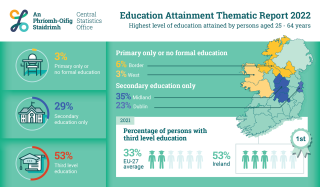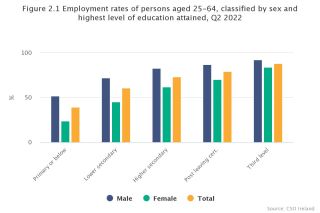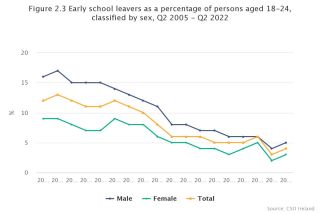Educational Attainment in Ireland

The most recent CSO Educational Attainment Thematic Report 2022 shows that Ireland continues to have one of the highest rates of third level education in the EU-27 with 62 per cent of 25-34 year olds in Ireland having a third level qualification in 2021, compared with the EU-27 average of 41 per cent. Younger age groups reported the highest levels of third level attainment, with around six in ten 25-34 and 35-45 year olds having a third level qualification, compared with approximately one-third (35%) of 60-64 year olds reflecting increased levels of participation in third level education over time. The impact of education on life outcomes is also evidenced in the report, and those with a third level qualification are more likely to be in employment.
Main findings:
- The 25-34 year old age group has the highest level of third level attainment at 63 per cent, followed by the 35-44 year old group at 58 per cent.
- Females across all age groupings (25-64 years) had higher levels of third level attainment than males.
- Females aged 25-64 years old with a third level qualification were more than three times more likely to be employed (84per cent) compared with females with a primary education or no formal education (24 per cent).
- Males aged 25-64 years old with a third level education had an employment rate of 92 per cent compared with males with a primary education or no formal education at 52 per cent.
- In Dublin, 62 per cent of those aged between 25-64 had a third level qualification in comparison with 46 per cent in the Midlands.
- Around 3 per cent of people aged between 25-64 had only a primary school education or no formal education, and 29 per cent had only a second level qualification.
- In 2021 Ireland was above the EU-27 average for third level attainment across all age groupings with the 25-34 year old grouping showing the largest difference at 21 per cent.
Educational Attainment and Employment
Employment rates for those aged 25-64 years old increased as the level of educational attainment increased with this relationship evident in both sexes. In Q2 2022, females aged 25-64 years old with a third level qualification were over three times more likely to be employed (84 per cent) compared to females with a primary education or no formal education (24 per cent). Comparing this to males aged 25-64 years old with a third level qualification, the employment rate was 92p er cent, dropping to a 52 per cent employment rate for those with a primary only education or no formal education.
Unemployment rates for those aged 25-64 years old generally decreased as the level of education attained increased. The difference in unemployment rates by education is larger for females than for males. Females with a primary education or none had an unemployment rate of 22 per cent compared to just 2 per cent of females with a third level qualification. For men, 8 per cent of those with a primary education or none were unemployed, compared to 3per cent with a third level education.
The labour force participation rate (number of persons in the labour force expressed as a percentage of the total population) is also impacted by educational attainment. Females aged 25-64 years old with a third level qualification were almost three times as likely to be in the labour force (87 per cent) compared to females with a primary education or below (31 per cent). The corresponding values for males in were 95 per cent and 57 per cent respectively.

Early School Leavers
In 2022, only 4 per cent of those aged 18-24 were defined as early school leavers (Early school leavers are persons aged 18 to 24 whose highest level of educational attainment is lower secondary or below and are not currently in education), a decrease from 12 per cent in 2005. Females aged 18-24 years old were less likely than males to be classified as early school leavers (3 per cent versus 5 per cent respectively).
Just under one third (32 per cent) of early school leavers aged 18-24 were not economically active. Just under half (48 per cent) of early school leavers were employed in Q2 2022, with 21 per cent unemployed.
Early school leavers had a lower rate of employment in compared with other persons aged 18-24 (48 per cent compared to 63 per cent). The unemployment rate for early school leavers was 21 per cent compared to 6 per cent for other persons aged 18-24.
The latest available EU figures showed that in 2021, 10 per cent of all 18-24 year olds in the EU-27 member states were classified as early school leavers. The Irish equivalent rate was 3 per cent in the same period. This ranked the country joint 2nd lowest with Greece and Slovenia among EU member states. This downward trend of early school leaving is a welcome development.
A 2019 report by the CSO analysed the outcomes for students who started second level education in 2011 – 2013. When comparing early school leavers to those who completed the Leaving Certificate, the report found that just 43.8 per cent of early school leavers were in employment compared to 74 per cent of their peers who finished school, and that the median earnings for early school leavers were €65 less than their peers (€345 per week compared to €410 per week). These figures are a cause of concern. The poor labour market status of early school leavers points to the need for a continued focus on this cohort and on addressing educational disadvantage. As we move towards a future where digital transformation will disrupt the labour market, having the greatest impact on people with lower levels of education and skills, it is important that this cohort are not left behind. A wide range of access options to education and training is pertinent when it comes to dealing with the issue of early school leaving.

Educational Attainment and Regional Differences
Regional differences were found in educational attainment rates. Around 6 per cent of people in the Border areas (Cavan, Donegal, Leitrim, Monaghan, Sligo) had attained primary-only or no formal education, while this figure fell to 3 per cent for people living in the West (Galway, Mayo, Roscommon), South-West (Cork, Kerry), Midlands (Laois, Longford, Offaly, Westmeath), and Dublin (Dublin City, Dún Laoghaire-Rathdown, Fingal, South Dublin).
When it comes to secondary education, 23 per cent of people living in Dublin had completed secondary school compared with 35 per cent of people in the Midlands. Looking at third-level education attainment, over three in five persons (62 per cent) aged 25-64 years old had a third level qualification attained a third level education, this compares to 46 per cent of persons aged 25-64 years old in the Midland region that have a third level qualification.
Policy priorities
The lifelong opportunities of those who are educationally disadvantaged are in sharp contrast to the opportunities for meaningful participation of those who have completed a second or third-level education as the latest CSO data confirms. If the Constitutionally-enshrined right to education is to be meaningful, there needs to be recognition of the barriers to learning that some children of school-going age experience, particularly in disadvantaged areas, which result in premature exit from education. In this context, second chance education and continuing education are vitally important and require on-going support and resourcing.
Although the funding available for education increased in Budgets since 2016, the deficits that exist within the system, particularly as a result of the impact of austerity budgeting, require significant additional resources. This requires the development of a long-term education policy strategy across the whole educational spectrum to ensure that education and continuous upskilling and development of the workforce is prioritised if Ireland is to remain competitive in an increasingly global marketplace and ensure the availability of sustainable employment.
Further Education has a key role to play to ensure we meet our lifelong learning targets and it must be supported and resourced to ensure we meet our targets.
Social Justice Ireland believes that the following policy positions should be adopted in responding to educational disadvantage:
- Make the improvement of educational outcomes for pupils from disadvantaged backgrounds and disadvantaged communities a policy priority, with additional resources focused on addressing the persistence of educational disadvantage.
- Commit to increasing investment in Early Childhood Care and Education by 0.1 per cent of GDP annually to reach 1 per cent of GDP by 2027.
- Commit to reducing class sizes and pupil teacher ratios at primary and post primary level by 1 point per annum to 2030.
- Revise our lifelong learning target to reach 15 per cent by 2022 and to reach 20 per cent by 2026, ensuring sufficient resources are made available.
- To meet the digital and green transition challenges develop an integrated skills development, digital transition, vocational training, apprenticeship and reskilling strategy.
- Fully resource ‘Adult Literacy for Life’ by increasing the adult literacy budget to €100 million by 2030, including €25 million to improve ancillary and support services.
- Develop a framework to deliver sustainable funding revenues for higher education over the next five years with a roadmap to 2028.